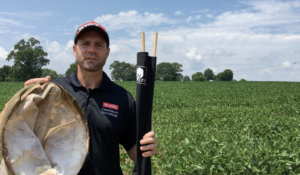Video: Corn Earworm in Soybean
go.ncsu.edu/readext?722003
en Español / em Português
El inglés es el idioma de control de esta página. En la medida en que haya algún conflicto entre la traducción al inglés y la traducción, el inglés prevalece.
Al hacer clic en el enlace de traducción se activa un servicio de traducción gratuito para convertir la página al español. Al igual que con cualquier traducción por Internet, la conversión no es sensible al contexto y puede que no traduzca el texto en su significado original. NC State Extension no garantiza la exactitud del texto traducido. Por favor, tenga en cuenta que algunas aplicaciones y/o servicios pueden no funcionar como se espera cuando se traducen.
Português
Inglês é o idioma de controle desta página. Na medida que haja algum conflito entre o texto original em Inglês e a tradução, o Inglês prevalece.
Ao clicar no link de tradução, um serviço gratuito de tradução será ativado para converter a página para o Português. Como em qualquer tradução pela internet, a conversão não é sensivel ao contexto e pode não ocorrer a tradução para o significado orginal. O serviço de Extensão da Carolina do Norte (NC State Extension) não garante a exatidão do texto traduzido. Por favor, observe que algumas funções ou serviços podem não funcionar como esperado após a tradução.
English
English is the controlling language of this page. To the extent there is any conflict between the English text and the translation, English controls.
Clicking on the translation link activates a free translation service to convert the page to Spanish. As with any Internet translation, the conversion is not context-sensitive and may not translate the text to its original meaning. NC State Extension does not guarantee the accuracy of the translated text. Please note that some applications and/or services may not function as expected when translated.
Collapse ▲Did you know that corn earworm (CEW) is our most important insect pest of soybean? It’s August, so NC State Extension Specialist Dr. Dominic Reisig tells us about CEW management in this short video.
August is time to scout for CEW in soybeans. They don’t show up in every field every year, so it is important to scout and treat only when necessary.
Scouting tools include a sweep net and a drop cloth.
Sweep nets are best for narrow row beans, planted at less than 30” spacing. We typically use a drop cloth in wide row soybeans, 30″ or greater. But drop cloths are also helpful when using a sweep net, to more easily sort through the contents of your sweep. If you also grow cotton, having a black drop cloth is optimal, but if you do not grow cotton, a light-colored one is fine.
Thresholds vary depending on the cost of control and what the crop is worth. In 2020, our CEW threshold is about 5 corn earworms in 15 sweeps, where a sweep counts as one sweep of the net. CEW can be very destructive to our crop by feeding directly on the pods, so it’s important we treat them, but it’s important we don’t spend money when we don’t have to.
When we’re sampling corn earworm we want to make sure we’ve hit the threshold before making a treatment decision. We have good beneficial insects that’ll take care of populations, and we even have diseases of the pest that will sometimes wipe populations out.
Be sure to check double-crop beans and any later planted beans. They love to lay eggs when soybeans are flowering so it’s very important we catch those infestations as we’re entering R3, and make treatment decisions anywhere from R3 to R5.
If we do hit the threshold it’s important that we use the correct insecticide of choice. Fortunately, in soybeans we have some very good products including Intrepid Edge, Steward, and Tracer. We have another good product known as Besiege or Prevathon. While it’s effective for corn earworm, we want to avoid using it in soybean so that we can preserve its use in cotton where we have many fewer insecticide options. Avoiding overuse of Besiege and Prevathon will delay the development of pest resistance and will help farmers of all of the crops affected by CEW.
Our Online Threshold Calculator is dynamic and includes the cost of control as well as the cost of soybean. For more details and photos of corn earworm visit our Corn Earworm page.



